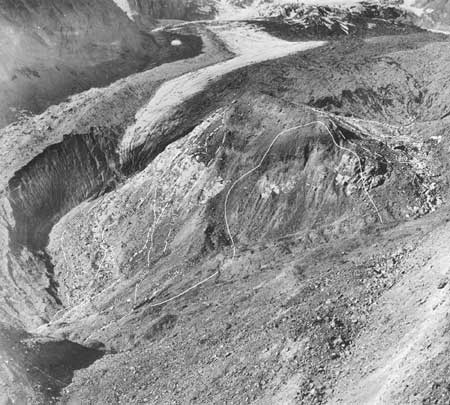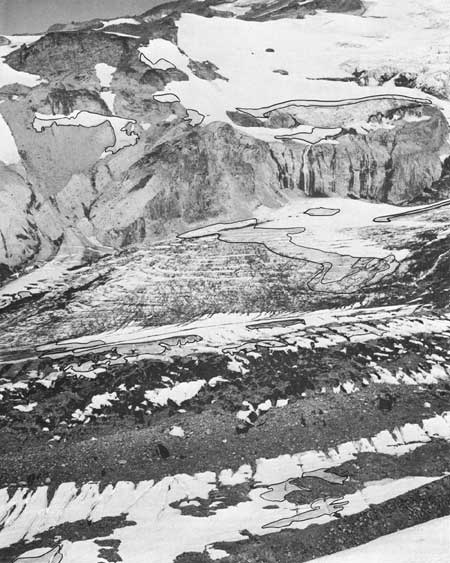
|
Geological Survey Professional Paper 631
Analysis of a 24-Year Photographic Record of Nisqually Glacier, Mount Rainier National Park, Washington |
QUANTITATIVE INTERPRETATIONS FROM THE PHOTOGRAPHS
(continued)
CHANGES IN LATERAL ICE MARGINS
Some of the ice-thickness analyses in the preceding section also indicate changes in position of the lateral ice margins of the glacier. Such changes are further illustrated by lines around the nunatak as shown on an enlarged part of the August 22, 1951, view from series 6 (fig. 13). The ice margins for each of the selected years indicated were transferred by tracing from one single weight print to another, over a very bright light. All the annual prints used must be enlarged to the same scale.
The maximum error incurred in figure 13 is estimated to be ± 30 feet (9 m) measured along the surface of the ground rather than vertically or horizontally; the average distance from the camera is 2,500 feet (760 m), varying from about 2,100 to 2,900 feet (640 to 880 m).
It was found that the topographic maps and cross-profile survey results currently available for this glacier do not contain enough detail to permit the derivation of as accurate data on changes in the ice margins, in some areas, as can be determined from photographs.
LONGITUDINAL SLOPE OF THE ICE SURFACE
The photographs in series 14-W (figs. 7-10) were found suitable for obtaining measurements of longitudinal slope of the glacier surface at profile 2. On each annual print the angle of slope was measured by protractor with respect to a vertical line (figs. 7-10) projected on the canyon wall at far end of the profile. The position of this line was determined from a phototheodolite view that was taken by the Conservation Division of the U.S. Geological Survey and was checked from a photograph taken by the writer in which a plumb-bob line was suspended in front of the camera. It was interesting to find that the general slope of the glacier is deceiving to the eye; it is greater than it appears, and thus makes the photographer unconsciously tilt a hand-held camera a little in a down-glacier direction.
A protractor was placed along the apparent crest of the dark ice in each picture on a reach 100-200 feet (30-60 m) in length. On a few of the annual prints, the top of the white ice near the far margin of the glacier may have been better than the dark ice as an index of the slope, particularly on the print for 1952 (fig. 8), where the white ice surface is especially prominent and is about 2 degrees steeper than the dark ice. However, in the photographs for most other years, the white ice either is too obscured or could be confused with the glacier's margin, so it was not used.
For comparison with the photographic results obtained from 1942 to 1965, slope values in the same period were determined from topographic maps for 1941, 1946, 1951, 1956, and 1961. (See fig. 14.) On each map a 200-foot (60-m) reach was used, drawn along the same ice ridge as appeared in the corresponding photograph to be the crest of the ice. Elevations between contours were interpolated. The results for 1951, 1956, and 1961 probably are more accurate than those for 1941 and 1946 because of the more refined procedures used in making the later maps. The results were used (Meier, 1968) in a study of the flow and stress in Nisqually Glacier.
The slope values obtained from maps are somewhat greater, by about 2 degrees, than the corresponding values measured on photographs. This is believed due to a lack of sufficient detail in the maps for this kind of a study; they do not completely reflect the short reach of flattened slope that occurs in the immediate vicinity of profile 2 in the east half of the glacier, which is discernible in some photographs. (See fig. 4.) See also the generalized slope values for the glacier given in the tabulation on page 5.
One source of error in the measurement of glacier slopes on photographs, under conditions similar to those at profile 2, is the effect of varying vertical angles of camera view that result from the different stages of the glacier. During the 18 years covered by this analysis, the mean altitude of the glacier surface along profile 2 fluctuated below the camera viewpoint at station 14 by amounts ranging from 110 to 240 feet (34 to 73 m). Thus, because of the downward angle of camera view, the longitudinal ice-surface profile appearing on the prints to be the crest probably lies on the far side of the true crest. In addition as the glacier surface rises and falls from year to year the crest seen on the photographs may shift laterally toward and away from the camera or, by chance, may lie at an angle to the main flow lines of the glacier.
The above factors create some relatively minor errors when glacier slopes measured on photographs are compared with those obtained from contour maps. However, the fact that the changes in slope obtained by the two methods are reasonably consistent with each other indicates that the photographic method, which is relatively low in cost, is accurate enough to be a useful and valuable accessory in a reconnaissance study of glacier slope.
Additional comments on the slope of the glacier are contained in the section "Crevassing and General Character of Glacier Surface."
SNOW LINES AND FIRN EDGES
Oblique photographs of a glacier taken from stations on the ground along only one side of a glacier were found to have but limited value for mapping and analyzing the boundaries of snow and firn. These photographs give fairly satisfactory coverage for that purpose on the full width of the glacier up to an altitude of about 5,800 feet (1,800 m), and on its eastern half up to about 6,700 feet (2,000 m). However, at higher altitudes some parts of the glacier surface are obscured by ice bulges or moraines or by slopes dipping away from the position of the camera. So, when these lines are to be mapped and it is not economical to have photographic stations at rather high altitudes on both sides of a glacier, it would be better to obtain aerial photographs.
In this report the lower edge of the snow is called the snow line, and the lower extremity or edge of the firn is called the firn edge. (See also footnote 1, p. 1.) The wide range in annual altitude of the snow line and firn edge on Nisqually Glacier from 1942 to 1965 and their extremely broken appearance are evident in the various photographs published herein. On a 1955 picture (fig. 15) taken from station 13 a few of the firn areas have been outlined to illustrate their scattered occurrence. Location of the firn edge ranged from about 6,000 to 7,300 feet (1,880 to 2,250 m) during the period covered by these photographs.
Position of the snow line in late summer of each year has been found to range between about 5,800 and 7,300 feet (1,750 and 2,250 m). An example of a well-defined snow line on this glacier is seen in the 1942 view in series 5 (fig. 20), where but little snow remained below 7,000 feet (2,100 m).
| <<< Previous | <<< Contents >>> | Next >>> |
pp/631/sec3a.htm
Last Updated: 01-Mar-2006


